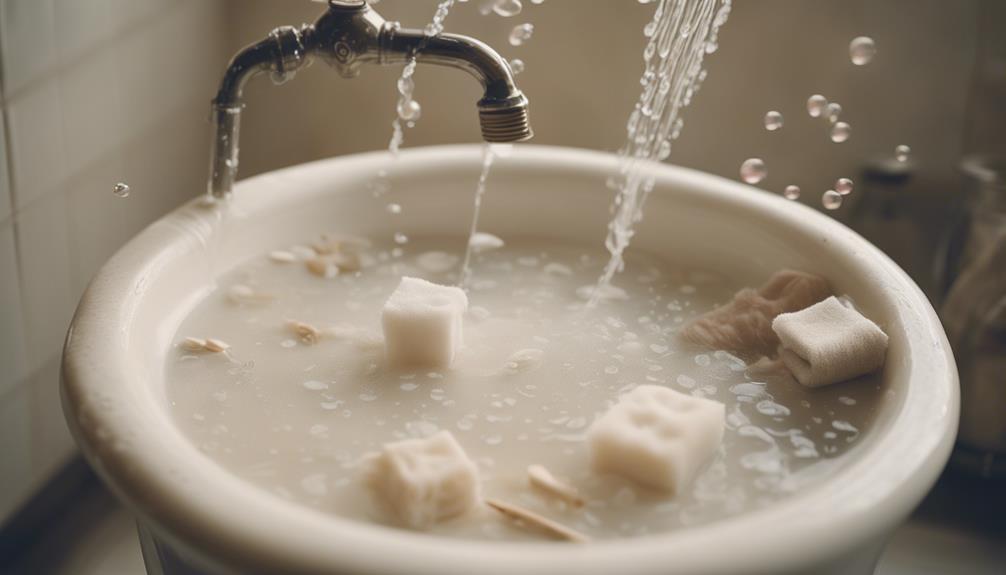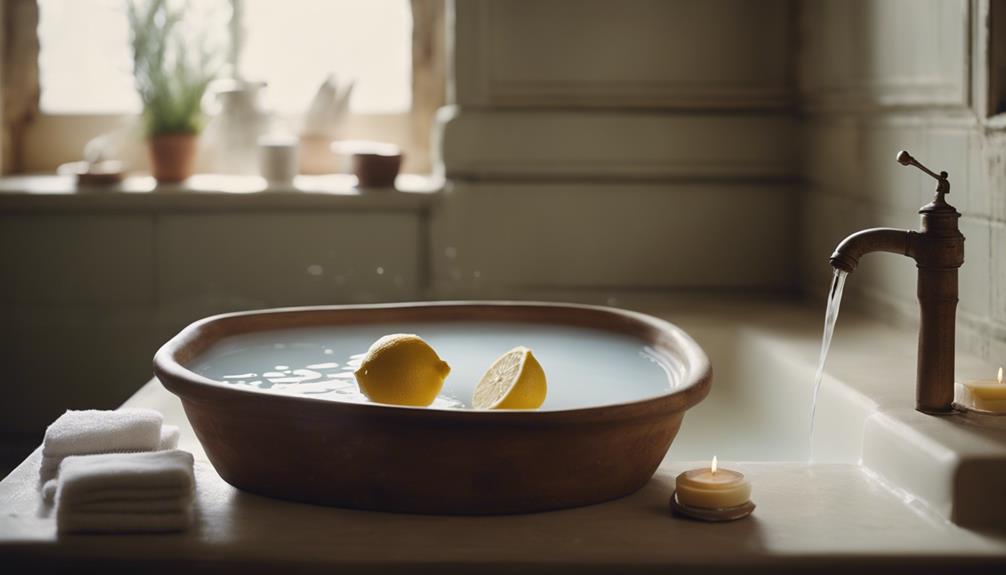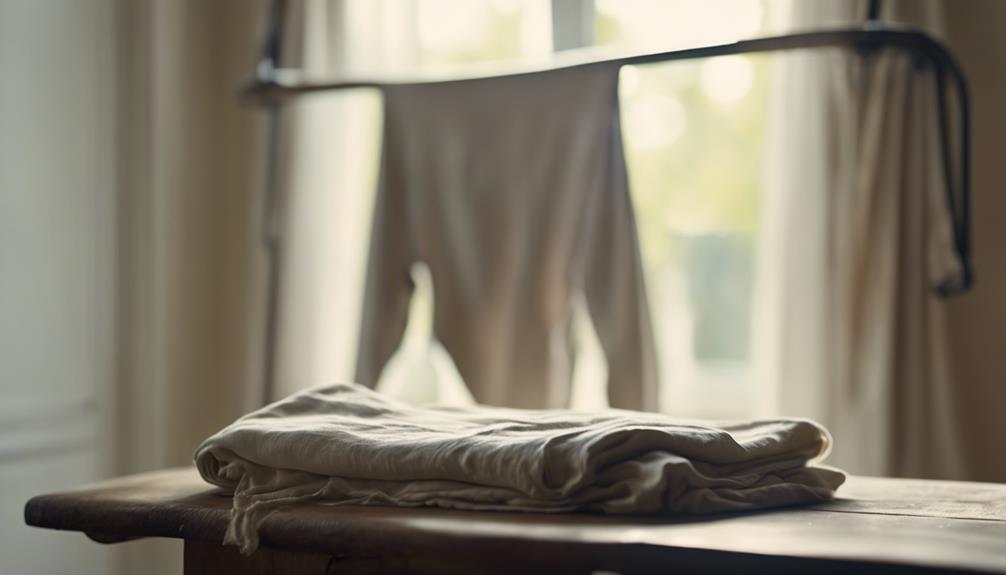To wash vintage linen trousers, start by inspecting the fabric for stains and damage. For minor stains, spot clean with a mixture of borax and Fels-Naptha. When washing, choose hand washing in cool water with a mild detergent, soaking for 15-30 minutes, or use a delicate cycle in a washing machine with a mesh bag. Always rinse thoroughly to remove soap. For drying, lay the trousers flat to prevent stretching and avoid direct sunlight. Iron while damp for a smooth finish. You'll discover additional tips on preserving their charm and integrity along the way.
Assessing Vintage Linen Condition

When you're getting ready to wash vintage linen trousers, the first step is to evaluate their condition thoroughly. Start by examining the fabric under bright light. This helps you identify hidden stains, tears, or signs of wear that may require special attention during cleaning.
While evaluating vintage fabric, you should also check for discoloration or yellowing, as these can indicate age stains or previous improper storage conditions needing specific treatment. Understanding the importance of label identification can also provide insights into the best care practices for your trousers.
Next, assess the overall integrity of the seams and hems. Confirm they can withstand washing without further damage. A gentle tug test can be beneficial here; if the fabric tears easily, it might be too fragile for laundering and may require professional care.
Document any findings, such as notable stains or areas of concern. This information will guide your cleaning vintage approach and help preserve the linen's history.
Stain Removal Techniques
Start the stain removal process by identifying the type of stain on your vintage linen trousers, as this will guide your treatment approach.
Different stains require different stain removal techniques. Here's how you can tackle them effectively:
- For minor stains: Create a spot cleaning solution using borax, washing soda, and Fels-Naptha. Apply it gently to the stained area with a damp cloth.
- For old or set-in stains: Soak the trousers in a solution of cool water and a gentle detergent for 30 minutes to 2 hours. Check periodically for improvement.
- For stubborn stains: Use a combination of lemon juice and salt for a natural bleaching effect. Apply this mixture directly to the stain and allow it to sit before rinsing.
- If stains persist: Consider repeating the soaking process or using a gentle enzyme-based cleaner designed for delicate fabrics.
Always remember to test for colorfastness on an inconspicuous area before applying any cleaning products.
This precaution helps protect your vintage linens from potential damage during the stain removal process.
Hand Washing Instructions

Washing your vintage linen trousers by hand guarantees they receive the gentle care they deserve.
Begin by filling a basin with cool water and adding a mild detergent specifically designed for delicate fabrics. Before you wash, inspect the fabric for colorfastness by dabbing a small, inconspicuous area with a damp white cloth to verify there's no dye transfer.
Once you've confirmed the fabric's integrity, submerge the trousers in the soapy water. Allow them to soak for 15 to 30 minutes, gently agitating the water to lift any dirt or stains without causing damage.
After soaking, rinse the trousers thoroughly in cool water multiple times to remove all soap residues. It's essential, as any remaining detergent can weaken the fibers over time.
After rinsing, lay the trousers flat on a clean, dry towel to absorb excess moisture. Reshape them gently, then air-dry them away from direct sunlight to prevent fading.
If you need to hang them, use a drying rack to maintain their shape. This careful hand washing process guarantees your antique linens remain in pristine condition for years to come.
Machine Washing Considerations
Before machine washing your vintage linen trousers, it's vital to check the care label for specific instructions to avoid any potential damage. Vintage linens can be delicate, and following the right steps guarantees they remain in great condition.
- Use a gentle detergent specifically designed for delicate fabrics.
- Set your machine to a delicate cycle with cool water to prevent color bleeding.
- Consider placing the trousers in a mesh laundry bag to reduce agitation and friction.
- Rinse thoroughly to eliminate any soap residues that can weaken the fibers.
When you choose the delicate cycle, you help preserve the integrity of the fabric. High temperatures can cause shrinkage or deterioration, so sticking to cool water is important.
Adding Borax can boost your cleaning power without resorting to harsh chemicals like bleach, which can ruin vintage textiles.
After washing, remember to rinse your trousers well to confirm no detergent lingers, as this can affect the fabric's longevity.
Soaking Methods for Tough Stains

Soaking vintage linen trousers is an effective way to tackle tough stains that regular washing mightn't remove. Start by soaking them in cold water mixed with a suitable stain remover like Oxy Clean or Biz. Let them soak for 24 hours to help lift set-in stains.
For yellowing or food stains, consider a vinegar bath. Mix one cup of white vinegar into the cold water and soak the trousers for 2-3 days. This method helps break down stubborn stains effectively.
While soaking, gently swish the trousers in the water every few hours. This agitation can enhance the stain removal process by helping lift dirt and stains. If the initial soaking doesn't yield satisfactory results, change the soaking solution and repeat the process.
Always monitor the fabric for any signs of dye transfer during this step.
After soaking, it's essential to rinse thoroughly. Remove all cleaning agents to prevent residues that can weaken the linen fibers and lead to further discoloration.
Following these soaking methods will prepare your vintage linen trousers for the next stages of washing, ensuring they remain in great condition.
Drying Best Practices
How can you effectively dry your vintage linen trousers while preserving their shape and integrity? The key is to follow a careful drying process that guarantees your trousers maintain their quality.
- Lay them flat on a drying rack or a baby gate to prevent stretching.
- Roll your trousers in a clean towel to absorb excess moisture without rubbing the fabric.
- Avoid direct sunlight, which can fade colors and weaken fibers over time.
- Ensure they air dry completely, which may take 1-2 days, depending on the humidity and temperature.
Ironing and Finishing Touches

Ironing vintage linen trousers is vital for achieving a polished look while maintaining their delicate fabric.
Start by ironing the trousers while they're still damp, as this helps achieve a smoother finish and prevents excessive wrinkling. Set your iron to a medium heat setting, and use steam or a pressing cloth to avoid direct contact with the fabric, which can cause shine or damage.
Always iron the trousers inside out to protect any decorative elements, seams, or embroidered details from scorching.
Lay the trousers flat on an ironing board, making sure the fabric is taut without stretching, to maintain their original shape and look. Begin with the waistband and pockets, then move down to the legs, being careful to work on one section at a time.
Once you've finished ironing, hang the trousers on a padded hanger or lay them flat to cool down.
This step is important as it helps set the pressed finish and prevents new creases from forming.
Storage and Preservation Tips
Proper storage and preservation of your vintage linen trousers is essential for maintaining their beauty and longevity. To protect your great vintage pieces, follow these simple yet effective tips:
- Store in a cool, dry place to prevent mildew and fabric degradation.
- Use breathable garment bags or acid-free tissue paper to shield against dust and pests.
- Regularly inspect for discoloration or pest damage to catch issues early.
- Avoid plastic containers, opting for cotton or linen bags instead.
Make certain your trousers are completely dry before placing them in storage. Moisture can lead to mold growth, compromising the integrity of the linens.
It's also a good idea to wash them in cold water and verify they're clean and unstarched prior to storage. This helps prevent any unwanted odors or mildew.
If you ever notice signs of deterioration, such as fading or pests, address these issues immediately.
Product Recommendations for Care

When caring for your vintage linen trousers, it's important to choose the right products to preserve their integrity and appearance. Start with gentle detergents like Oxy Clean or a wool-specific detergent. These options maintain the fabric's quality without exposing it to harsh chemicals.
For minor stains, consider a mixture of borax, washing soda, and Fels-Naptha for effective spot cleaning. This combination works well without damaging the linen.
Additionally, using white vinegar in the rinse cycle helps remove soap residues and enhances the brightness of your trousers, making sure they look fresh and vibrant.
If you encounter yellowing or food stains, lemon juice can be a natural alternative. Mix it with salt to create a bleaching effect that's gentle on the fabric.
Before using any new cleaning product, always test it on an inconspicuous area of your trousers to check for colorfastness. This step is vital to avoid any unexpected damage.
Frequently Asked Questions
Can You Wash Vintage Linen?
Yes, you can wash vintage linen. Just check the care label first. Use cool water and a mild detergent. Consider hand washing or a delicate cycle, and always air dry to preserve the fabric's quality.
Can You Put Linen Trousers in the Washing Machine?
Yes, you can put linen trousers in the washing machine, but always check the care label first. Use a gentle cycle and cold water to preserve the fabric, avoiding bleach or harsh detergents for best results.
How Do You Whiten Yellowed Vintage Linens?
To whiten yellowed vintage linens, soak them in cold water mixed with white vinegar. For tougher stains, use a Borax solution in hot water. Limit sunlight exposure and monitor progress to prevent damage or fading.
Is Oxiclean Safe for Vintage Linens?
Yes, OxiClean's generally safe for vintage linens if used properly. Test for colorfastness first, soak in dissolved solution for 1-2 hours, and rinse thoroughly. Avoid delicate fabrics to prevent damage from agitation. Limit use to protect fibers.





I don’t think the title of your article matches the content lol. Just kidding, mainly because I had some doubts after reading the article.